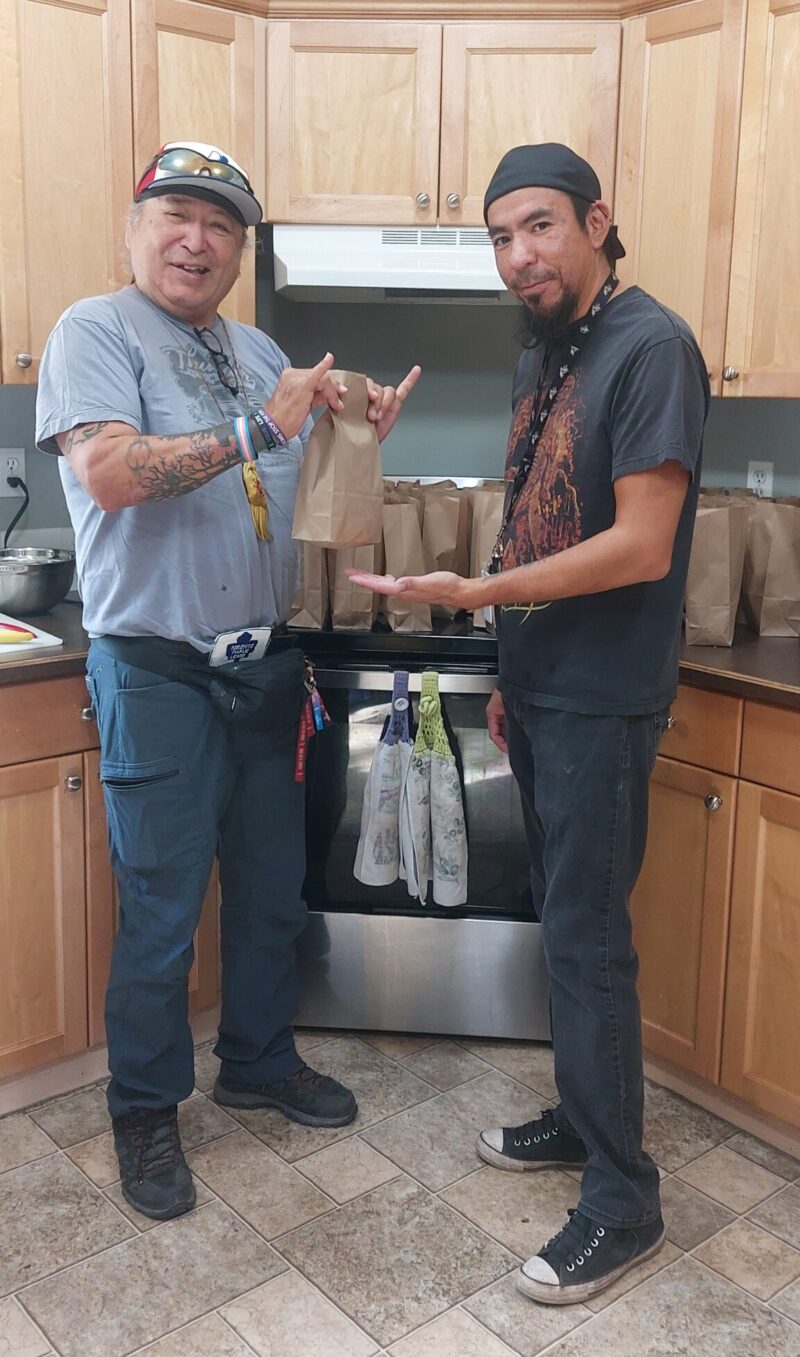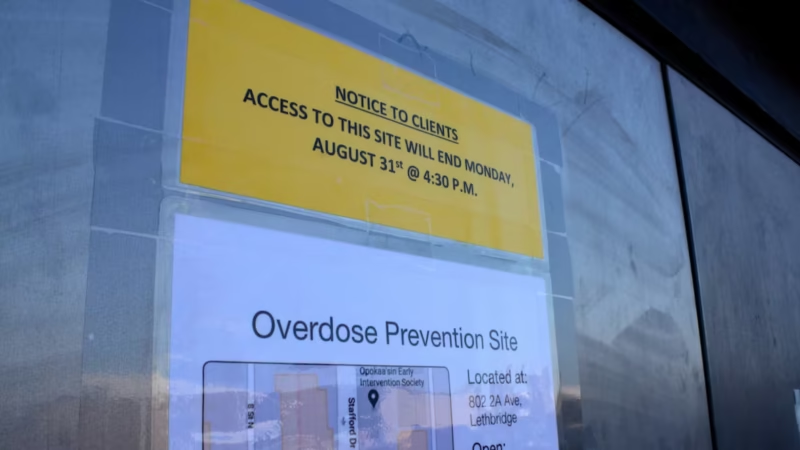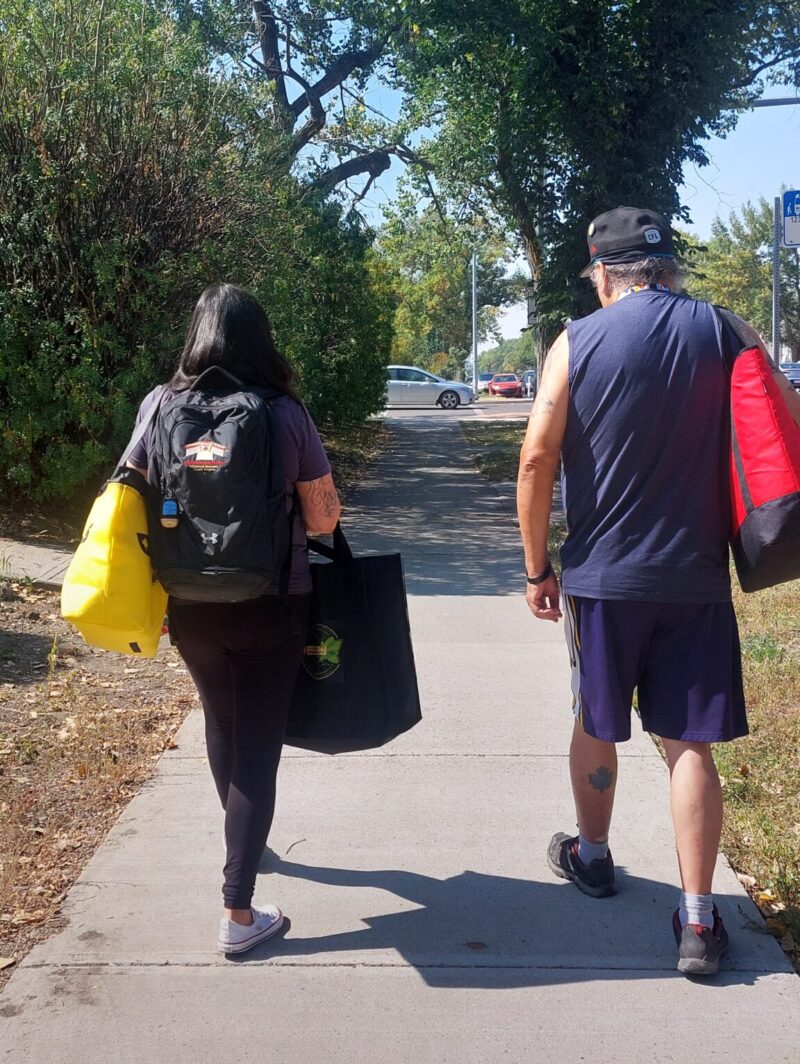World Homelessness Day
October 10, 2025 marked the 16th annual World Homelessness Day. A Global Day of Celebration for the work to prevent and end homelessness and alleviate the suffering of those experiencing it. Shelter, a place to rest and find comfort, is one of the most basic elements of safety.
On this day, ARCHES and the IRC program offered a celebration meal to the community. We chose this date to coincide with the Thanksgiving holiday. We are thankful for each other, but we reject a superficial gratitude which doesn’t extend to the relationships carefully crafted with ksááhkomma/ the Earth, over generations.
The Aboriginal Standing Committee on Housing and Homelessness (2012) reports that “Indigenous homelessness is not defined as lacking a structure of habitation; rather, it is more fully described and understood through a composite lens of Indigenous worldviews. These include: individuals, families and communities isolated from their relationships to land, water, place, family, kin, each other, animals, cultures, languages and identities. Importantly, Indigenous people experiencing these kinds of homelessness cannot culturally, spiritually, emotionally or physically reconnect with their Indigeneity or lost relationships”
By understanding homelessness as a disconnection from a validating way of life, it’s easier to understand why people outside the gender binary, facing the history of suppression and erasure associated with a core element of their identity, are disproportionately represented in homeless populations.
At ARCHES we think about the right to housing, and protecting access to all social determinants of health, as a form of health promotion and harm reduction. By harm reduction, we mean an intervention specially aimed at preventing worse future harm.

ARCHES-IRC staff prepare meals for community outreach. Image courtesy ARCHES Lethbridge
Harm reduction is integral to the mission of ARCHES, the AIDS Out Reach and Community Harm Reduction Education and Support Society. Unfortunately we must confront how this term, like thanksgiving, can unfortunately also represent a more insidious, deeper forms of abuse and mistrust.
Harm Reduction
In the traditional sense, harm reduction refers to a public health principle in which service providers, health educators, and policy-makers approach any behaviour contributing to personal or community illness, in a way that minimizes the negative health, social, and legal impacts of these behaviors. The approach emphasizes autonomy and the importance a culturally-validated personal identity in reclaiming one’s health. Founded on self-determination, harm reduction bridges human rights with public health goals. Harm reduction is integral to including people with lived experiences the process of transforming service delivery systems.
Like trauma-informed care or patient-centered practices, harm reduction can be applied in concerted efforts against almost any public health issue. We can think about food labeling for nutrition information, or seat belts and carbon emission capture and storage as forms of harm reduction. They systematically minimize the risks and impacts of inherent harms involved in human behaviours like eating or travelling.
For STBBI, strategies can include sexual health education, vaccinations for Hepatitis A and B, PrEP and PEP for HIV, opioid agonist therapy and safe supply initiatives. These all disrupt transmission of pathogens, while providing an important link to more specialized services.
One of the most visible and controversial forms harm reduction in Lethbridge was the ARCHES Safe Consumption Site. In principle, consumption sites are safely monitored spaces for people who use drugs to manage their addictions. Consumption sites are approved and inspected by Health Canada. Based on the evidence behind the sites, when properly established this these sites can:
- reduce the risk of accidental overdose, because people are not rushing or using alone
- connect people to social services like housing, employment assistance and food banks
- provide or connect people to healthcare and treatment
- reduce public drug use and discarded drug equipment
- reduce spread of infectious diseases, such as HIV
- reduce strain on emergency medical services, so they can focus on other emergencies
- provides space for people to connect with staff and peers, which can help a person moderate their drug use and decide to pursue treatment
The safe consumption site in Lethbridge was only a short-lived experiment. None of the previously federally approved SCSs in Alberta are operating at this time. In Lethbridge, the SCS lost support from the provincial health ministry in part on grounds allegations of financial mismanagement. These allegations emerged in the midst of public complaints and popular misunderstandings around the site’s operations. The SCS was seen as doing too little to prevent the harm that many of the community members close to the issue cared about most. In the aftermath, the most vulnerable people associated with the care service lost their access to a crucial form of support.

Notice advising the supervised drug consumption site closure on Aug. 31, 2020 (Bryan Labby/CBC https://www.cbc.ca/news/canada/calgary/lethbridge-arches-supervised-consumption-site-closure-1.4434070)
Harm reduction is a way to fight the spread of STBBIs. More than that, the principle reflects the dual essence of compassion and autonomy in care work
To end homelessness and reduce the suffering caused by health disparities driven by isolation and marginalization, we recognize the consistent and empathetic everyday work of creating a just, inclusive, and healthy society.
One of the ways to practice harm reduction is to celebrate life when we can. For many of us, being alive today means facing harsh times and dark shadows on the horizon. Many of us suffer from addictions by way of pain management, finding our own way to minimize the deep suffering and trauma in our interconnected histories.
Let’s practice gratitude in a way that respects the sources of what we’re grateful for. Likewise, let’s practice harm reduction in ways which acknowledge and redress the underlying sources of disparity and disease.

IRC staff walk to share food, information, and inspiration
With gratitude and hope.
ARCHES Queer Health
Resources
Blackfoot: online dictionary: Home
Definition of Indigenous Homelessness in Canada | HomelessHub
LGBTIQ+ Homelessness: A Review of the Literature
Supervised consumption explained: types of sites and services – Canada.ca
World Homeless Day 10th of October
